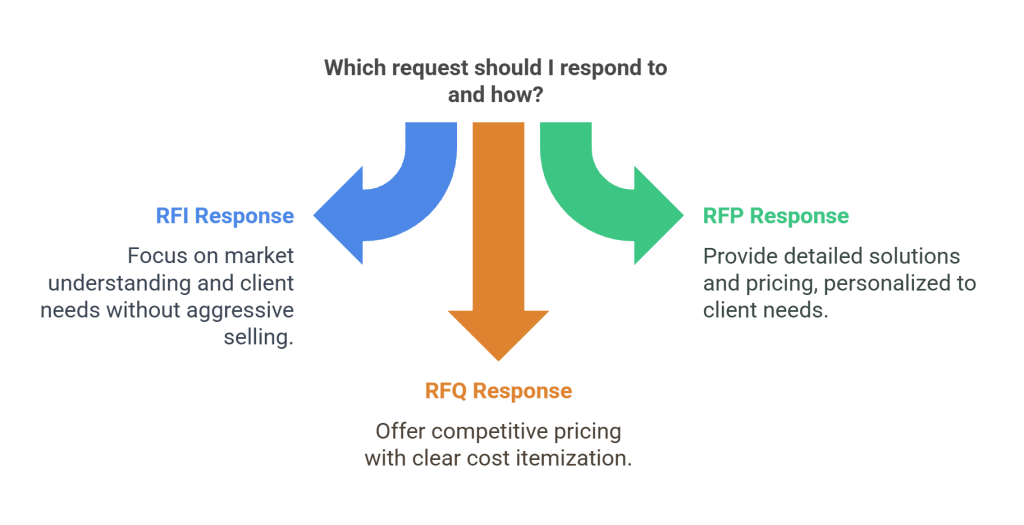You can’t really respond to something the right way if you don’t fully understand what it is in the first place. And to be honest, sometimes we think we know what terms like RFP, RFQ, and RFI mean… and sometimes we’re just winging it. That’s why this article is worth your time. It explains the difference between RFP vs RFQ vs RFI. Even if you’re already familiar with all three, give it a quick read. You might catch something you’ve missed or misunderstood before. A little clarity can go a long way when it comes to writing stronger, smarter responses and improving your chances of actually winning.
Understanding RFI, RFP, and RFQ Process Clearly
Just to get on the same page and to make things clear from the get-go, let’s begin by defining our acronyms:

- RFI (Request for Information): Usually the first step. It’s about gathering information, not making immediate purchasing decisions.
- RFP (Request for Proposal): Businesses are actively seeking solutions, details, and pricing from vendors.
- RFQ (Request for Quotation): Companies know exactly what they want and are looking for specific price quotes.
RFI, RFP, and RFQ aren’t separate silos. They’re usually different stages in the same buying process. Some companies use all three. Others skip a step or two. But when they’re all in play, they usually follow a simple flow: first comes exploration (RFI), then evaluation (RFP), and finally the logistics and pricing (RFQ).
It’s helpful to know what each one means, but even more helpful to know how they actually show up in the real world. You won’t always get all three. Sometimes the RFP comes out of nowhere. Other times, the RFI is the only step. The key is recognizing what stage they’re in and shaping your response to match it.
What is an RFI (Request for Information)?

When to Use an RFI and How to Respond Effectively
Think of an RFI as a fact-finding mission. Companies issue RFIs when they’re not quite ready to buy but need to understand the market better.
Tips for Crafting an Effective RFI Response
- Keep it concise: Clear, straightforward information wins.
- Share your expertise without pushing too hard to sell.
- Demonstrate understanding of the client’s potential needs and future goals.
Examples of RFI Situations
- A company is exploring new software but isn’t sure what’s available.
- A government agency needs preliminary details from potential contractors.
What is an RFP (Request for Proposal)?
How To Prepare RFPs to Win More Deals
An RFP indicates serious buying intent. Companies clearly outline their needs and expect detailed solutions and pricing.
Key Elements of an Effective RFP Response
- Answer clearly and specifically to each requirement.
- Personalize your proposal—generic responses rarely succeed.
- Include clear pricing models, timelines, and deliverables.
Common Mistakes When Responding to RFPs (And How to Avoid Them)
- Ignoring detailed instructions: Always follow the client’s requested format.
- Overpromising: Be realistic and transparent.
- Forgetting the “why us” factor: Clearly articulate what sets you apart.
What is an RFQ (Request for Quotation)?
How To Prepare RFQs to Streamline Your Sales Process
An RFQ means the buyer knows exactly what they need. They just want the best price.
Tips for Crafting a Winning RFQ Response
- Offer accurate, competitive pricing.
- Provide a clear itemization of costs.
- Highlight value-added services or guarantees that differentiate you.
Best Practices to Respond Quickly and Accurately to RFQs
- Maintain a pricing database for quick reference.
- Standardize your quotation templates.
- Respond promptly to show efficiency and reliability.
RFP vs RFQ vs RFI: Quick Comparison Cheat Sheet

Easy Reference to Choose the Right Response Every Time
- RFI: Focuses on information gathering; minimal pricing details.
- RFP: Requires detailed solutions and comprehensive pricing.
- RFQ: Needs precise pricing for specific products/services.
Common Scenarios Explained Simply
- Use an RFI when the buyer isn’t sure what’s out there.
- Respond to an RFP when a detailed, customized solution is requested.
- Opt for RFQ responses when the buyer clearly defines what they need and seeks pricing.
Mistakes Businesses Make When Choosing Between RFI, RFP, and RFQ
Avoid These Costly Missteps for Better Sales Outcomes
- Treating RFIs like RFPs: Remember, RFIs are about educating, not selling.
- Providing complex details in an RFQ: Stick to what’s requested—clear pricing.
- Using generic templates for RFPs: Customization is essential for winning proposals.
How to Streamline Your Response Process: Tools and Techniques
Using Technology to Master RFI, RFP, and RFQ Responses
Automation and AI tools can dramatically improve your efficiency and accuracy.
- AI and Proposal Management Software: Solutions like AI proposal tools can automatically draft and organize your responses.
- Automation Benefits: Faster turnaround, fewer errors, and more consistent quality.
- Recommended Tools: Platforms like Loopio, AutoRFP.ai, and Proposal Biz (coming soon!) can make the response process seamless.
Picking the Right Response Strategy Every Time
Knowing the differences between RFIs, RFPs, and RFQs and responding appropriately can be your competitive edge. When you get it right, your business looks organized, professional, and genuinely attuned to customer needs.
Next time an RFI, RFP, or RFQ lands in your inbox, reference this guide. Respond right, win more deals, and spend less time stressed out by confusing acronyms.
And if you’re interested in streamlining your responses even further, we’re building Proposal Biz, a smart tool designed to simplify your entire response process. Want to be among the first to try it out? Join our insider community today!